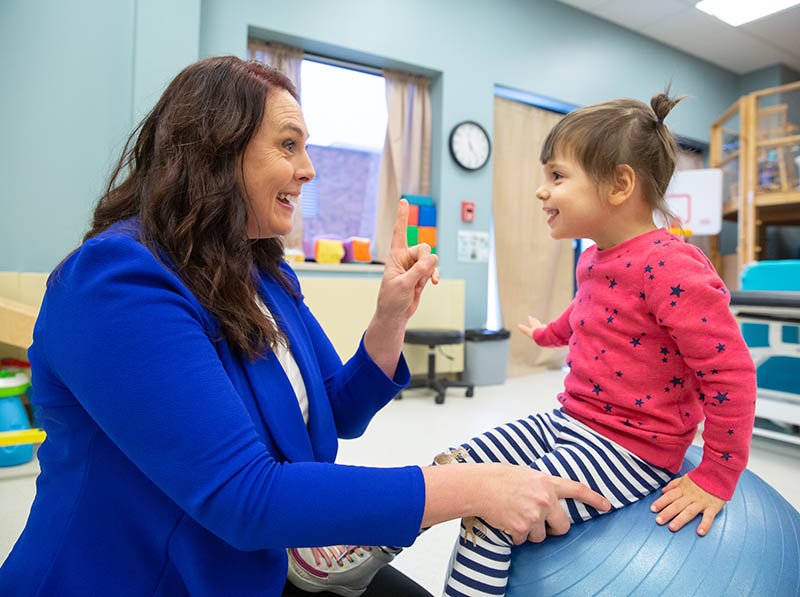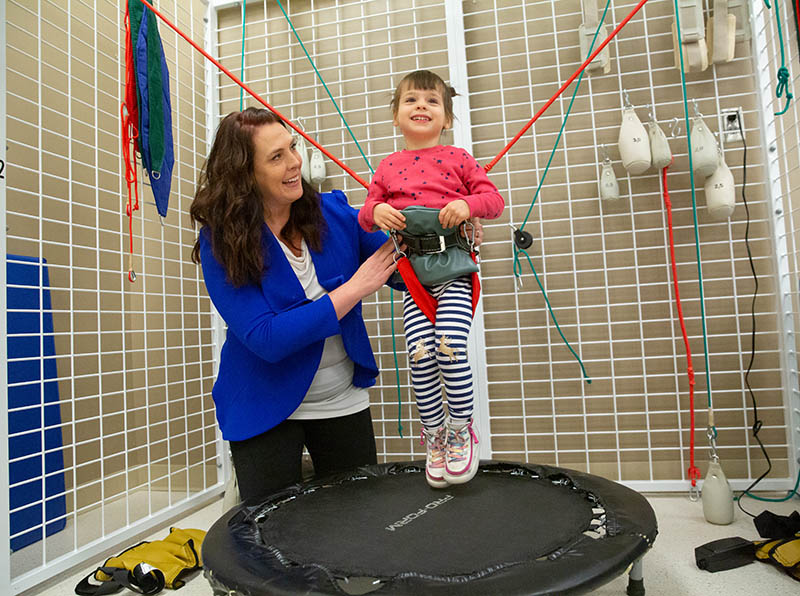The call came unexpectedly, and the very next day, Katherine Monkman’s family picked up their newborn girl. And then also quickly picked up some preemie clothes.
Halle Houchins had been born several weeks early. Monkman hadn’t even learned yet that Halle’s birth mother had chosen Monkman’s family to adopt her.
In a birth with no complications, weighing 5 pounds 2 ounces — half of what her adopted older sister, Quinn, had weighed at birth — Halle seemed healthy.
However, Monkman thought, she did cry a lot compared to Quinn, “the easiest baby you could have.” She also threw up — every bit of formula she swallowed.
But it still surprised Monkman, at Halle’s well child visit at about 2 months, when her Sanford Health pediatrician expressed concerns. She said Halle wasn’t displaying the milestones that she should have reached by then. But she did offer a possible solution for Halle’s vomiting: physical therapy.
That suggestion more than three years ago began a relationship that Halle and her mom have relied on ever since. It’s helped them each make progress in their lives — in very different ways.
Responding to delays
Monkman could see a difference right after Halle’s first session with physical therapist Tonya Onstad, who works at Sanford Bemidji Children’s Therapy in Bemidji, Minnesota. Onstad demonstrated some maneuvers that could be performed before the infant drank.
Onstad also suggested exercises to help with Halle’s torticollis. That’s a condition where the neck is twisted and head tilted.
At Halle’s next well child check, to Monkman’s dismay, her pediatrician discovered additional milestones she wasn’t meeting.
Related: Well child visits important for children of all ages
Monkman followed her suggestion to meet with the state’s early intervention services, which aim to help infants and toddlers with developmental delays and disabilities. Monkman remembers crying through the whole meeting. Her daughter didn’t seem to be doing anything she should be: sitting up, babbling, reaching for things.
After adding early intervention services, occupational therapy and feeding therapy appointments, Monkman was taking Halle to six a week — while working a full-time job.
“Looking back, I don’t know how I did it. You just do what you have to do,” she said. “But you want to give your child every opportunity.”
For reasons that Monkman may never know, it takes Halle a very long time to reach milestones. They come mainly after continual, repetitious work on those skills at therapy and at home. For example, Monkman said, “Halle was 14 months before she could sit up,” a skill infants half that age may be able to do.
Halle is considered to have global developmental delay, a general term referring to delayed milestone skills in various areas of a child’s development.
‘We look at Halle’s whole system’
Global developmental delay is not a disease diagnosis. There’s no awareness campaign for it; no big fundraising efforts to research it; no particular medicine to treat it. It’s also not automatically a disability.
Lean more: How Sanford Health cares for kids with developmental delays
Monkman calls therapy Halle’s medicine. Because of it, she started crawling, then using a small walker, then finally walking independently last year.
Halle loves working with Onstad, who “is just like another auntie or something,” Monkman said.
Onstad has worked as a physical therapist for 20 years, the past seven and a half at Sanford Bemidji Children’s Therapy. She also works as the school district’s physical therapist for part of each week.
“We don’t treat according to diagnosis. We treat based on impairment,” Onstad said. “So we look at Halle’s whole system, how her balance system works, how her muscles work, how her sensory system works, what she feels through her skin, what her vision perceives.”
Then she tries to use different activities to help her get around better. Onstad could tell early on that how Halle felt her feet kept her from improving on her walking skills. One appointment, she might seem so hypersensitive that she didn’t want her feet to touch the floor at all; the next appointment, she might pound them into the floor, Onstad said, as if to say, “Give me more feedback. I have no idea where my feet are.”
“It took a long time to kind of put the pieces together to get her to understand where her feet were, and that her feet were connected to legs that were connected to her body, and that she could move through the world that way.”
Goals and obstacles
Braces helped give Halle a better sense of her feet, and she walked with her walker. But when Onstad started working with her in the spider cage last fall, then she really started walking independently. The spider cage is a large framed box that can use a system of cables and weights to help physical therapy patients. In Halle’s case, having some resistance and working against gravity helped ground her and really realize where her feet were, Onstad said.
Enlarge

Photo by Travis Jensen, Sanford Health
Onstad’s current goals for Halle are to be able to jump — to get both feet off the floor at the same time. That’s a typical 2-year-old skill. She’s also working on going up and down stairs safely, as well as navigating a room that has multiple obstacles without falling. She tends to not be aware of objects or varying surfaces on the floor and then can easily trip and fall. So she’s learning to step over things.
That’s one key preparation for a classroom environment, where toys and colorful, educational rugs can represent fun to other kids but represent hazards to Halle.
That’s not her only obstacle to the classroom, however.
Halle is normally a “super social kiddo,” her mom said. “She smiles, she laughs.” And even though she’s not speaking verbally, she communicates a few words by signing, such as “please” and “all done.” Or if she’s tired, she indicates it by flopping on her bed; if she’s hungry, she’ll try to climb into her high chair.
But her sensory system can easily become overstimulated in groups of people: the colors, the noise, the movement. She might spend just a short time in a classroom, but her family might see — and manage — the effects of her dysregulation for a couple of days afterward.
Helping find resources
Onstad was instrumental in helping with Halle’s physical accomplishments, but she’s helped with more, too. Monkman is grateful that Onstad pointed her in the direction of resources to help Halle keep getting the treatment she needs. Monkman had worked as a social worker in the health care field, but she still learned and took action on a lot because of Onstad’s guidance.
After Halle was determined to have a disability, Monkman was able to get medical assistance for her. That helps pay for therapies and a personal care assistant, who can take Halle to appointments while Monkman works, among other tasks.
Besides her hands-on work with children in therapy, Onstad considers it part of a therapist’s job to help families find resources that benefit their child. One big concern: ensuring that a child can come to a therapy session. She helps them figure out how to address the barriers that might keep them away.
“The child can’t make progress if they can’t get to therapy. They can’t get to therapy if they don’t have transportation,” Onstad said. So she helps guide families struggling with this issue to a program that reimburses gas money, or supplies them with bus tickets.
An occupational therapist on staff helps meet children’s needs by her sewing talent. So if Onstad thinks of a device that could help support one of her physical therapy kids, her co-worker can custom-make it for that child. In Halle’s case, it was a special pair of shorts that would fit her thin frame to wear for support during a certain activity.
“That entire pediatric department — they’re angels, what they do,” Monkman said. “They just go above and beyond for those kiddos.”
Supporting the family
The lack of a diagnosis for Halle has been frustrating for Monkman. She has tried genetic testing — again with Onstad lending a hand — to see if a cause for Halle’s condition could be identified.
“I had to know,” Monkman said. “I had to pursue every avenue that I knew was available to me.”
She’s especially concerned that when Halle reaches adulthood, services will be much harder for her to get without a specific diagnosis.
But the tests for Halle and her birth parents revealed nothing.
Learning to accept this unknown has changed Monkman.
“Traditionally I was a very Type A person. I wanted to have control over situations in my life. And with Halle not having a diagnosis and not being able to, there’s just so many things you have to let go of. And part of that struggle, Tonya helped me with, too,” Monkman said.
“Yes, she was working with my child, but she also was like a lifeline to me as just a support.”
‘Seek help’
Onstad considers it part of her job to do what she can to help the social and emotional part of a child’s life as well as the physical.
Sanford Bemidji Children’s Therapy can help a wide range of issues, Onstad pointed out. Even if a child has what seems like a small speech problem to a parent, it might seem like a huge problem to a kindergartner getting made fun of by their classmates. And it might only take a few visits with a speech therapist and at-home exercises to keep that child from disliking school and limiting communication.
“Why put your child through a year’s worth of emotional struggle when it could get better in a couple months?” Onstad asks. “Seek help. Don’t think it’s something that just goes away.”
More stories
- Pediatric physical therapy in the classroom
- Netflix ‘Diagnosis’ family searches for rare disease clues
- Girl finds support in specialists for rare disorder, cancer
…
Posted In Allied Health, Children's, Inclusion at Sanford, Rehabilitation & Therapy
